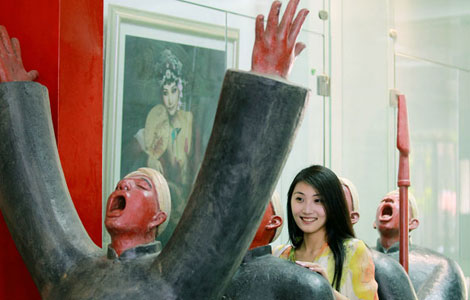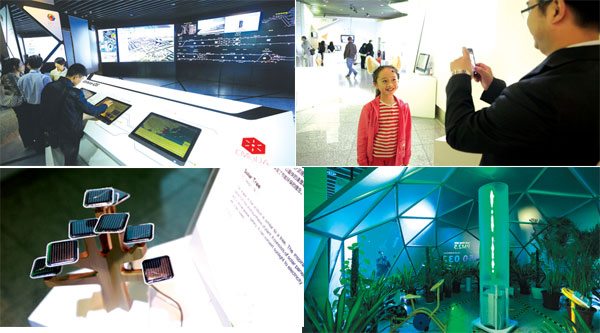Design a better life
Updated: 2013-10-09 07:45
By Sun Yuanqing (China Daily)
|
|||||||||||
How to make a city more liveable through design and technology? Smart City 2013 - International Design Exhibition, the main exhibition at Beijing Design Week 2013, provides some suggestions. Sun Yuanqing checks it out.
As another smoggy day dawns, Beijing is seeking solutions in a new direction: design.
Evolving from the traditional role, design is now being applied in smart city development as a more accessible way to integrate and present urban information, service and management systems.
Smart City 2013 International Design Exhibition, the main exhibition at Beijing Design Week 2013, provides a preview of how innovative digital design will change modern cities for the better.
|
Clockwise: The Necomimi headband attracts children; The Eco Air Bubble improves air quality; The Solar Tree expresses an environment friendly concept; The Urban Operating System integrates city, traffic, security and emergency management into one platform. Photos provided to China Daily |
"We want to explore how design, coupled with technology, can improve urban living," says the curator Yang Lei, who is also a jury member of Digital Communities of Prix. "It is not only the authority's job to solve urban problems. More importantly is how we can use technology and design to improve our life as citizens."
The exhibition serves as a scheme for the National Smart City Innovation Centre at China Millennium Monument Museum of Digital Art in 2014, which aims to stimulate smart city development.
Smart city development has become the latest hype in China as the country rapidly urbanizes. It is estimated that 70 percent of the Chinese population will live in cities by 2050, which poses a critical challenge to the current city management system.
Beijing is not the only mega city seeking solutions for smog and traffic problems through digital design ideas. This year sees the booming of 202 smart pilot cities in China, supported by the government. And the blue print will come from Smart City 2013 - International Design Exhibition.
The exhibition includes three sections, Smart City Public Platform, Smart Living and Smart City, covering areas such as urban planning, living and urban mobility. There are 58 works from 40 international design studios.
In the section of Smart City Public Platform, application systems analyze and share urban information collected from all sources, including individual smart phones, to provide better public service.
For the creativity industry, it also means possibilities for new formats as audiences around the globe can join any smart phone-powered event regardless of the locale and time.
The Global Choreography dance by artist Sander Veenhof and choreographer Marjolein Vogels is an example. The dance consists of 33 moves with a smart phone in hand. Dancers are guided by the augmented reality cubes in their smart phones. The cubes are centrally directed so people from around the world can join the dance simultaneously.

The pace of each participant will impact dancers across the world so every one contributes to a new dance upon joining.
"When it is used around the world, we can dance together and create a new piece of dance," says Veenhof.
The Smart Living Section presents professional sensors that can turn into smart wearable personal assistants to monitor personal health and emotions.
The biggest attraction for children and young women on site is the Necomimi by NeuroSky, a lovely looking headband that swings according to the wearer's moods.
With a MindWave brain wave sensor that detects brain waves, the cat ears stand straight when the wearer concentrates and face down when the wearer relaxes. When the wearer is delighted or particularly interested in something, the ears will swing back and forth.
Another highlight is the Eco Air Bubble that generates oxygen through the collaboration of human power, green plants and air quality monitoring.
Inspired by the communal fitness centers in the residential compounds in Beijing, Fei Jun, artist and founder of Interactive Beijing, remodeled the exercise machines to generate power for the air purification mechanism.
When people exercise, they are at the same time generating energy for the air purification system connected to the fitness facilities. Three chosen green plants produce fresh air while the indoor and outdoor PM2.5 levels are updated on the facade of the bubble.
"This pilot is made to demonstrate how we can change our air quality with the help of public participation," Fei says. "Before the government can pull off effective measures, we contribute what we can. Here, design is no longer a concept, it can solve the most urgent problems in life."
The Smart City section explores how the data provided by citizens can be used to solve urban issues like transportation, energy and safety.
The Beijing Traffic Congestion Map by Wang Zuchao, a PhD student from Peking University, shows the congestion patterns in Beijing in an intuitive way. Different colors indicate the various levels of congestion to give the drivers a clearer picture of the road condition.
For the past 30 years, Chinese cities have been trying to contain their residents amid rapid expansion. However, the feelings of the residents have been largely neglected, says Huang Yan, director of Beijing Municipal Commission of Urban Planning.
"We have been proving that we can survive in the past. Times are different now. We will focus on city dwellers in the future. That's why we should learn from European cities like Amsterdam, they have always cherished the value of the people in the city," Huang says. Amsterdam is the guest city of the Beijing Design Week 2013.
China is known as the testing ground for the world's boldest design ideas, however, that is likely to change in the future, Huang says.
"Landmarks and eye catchers were what we wanted. Now, we want designs that make our cities more livable and our life better," Huang says. "And that's why we are going to work with designers from Amsterdam more closely than before."
Contact the writer at sunyuanqing@chinadaily.com.cn.
(China Daily 10/09/2013 page18)
Today's Top News
CNOOC offering 25 blocks for cooperation
Li plans to seek deeper trust with neighbors
Obama to name Yellen as next Fed chair
Obama says he'll negotiate once 'threats' end
Xi calls for more APEC connectivity
Hey, big Chinese spenders
Wet weather fails to dampen FTZ interest
Service-sector expansion slows
Hot Topics
Lunar probe , China growth forecasts, Emission rules get tougher, China seen through 'colored lens', International board,
Editor's Picks

|

|

|

|

|

|






